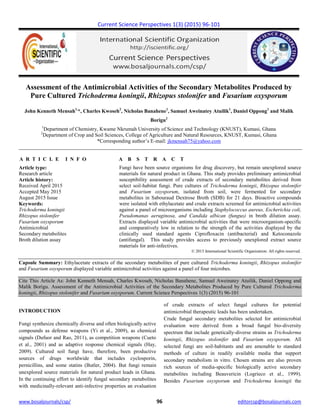The document summarizes a study that assessed the antimicrobial activities of secondary metabolite extracts from three soil-inhabiting fungi - Trichoderma koningii, Rhizopus stolonifer, and Fusarium oxysporum. The fungi were cultured individually in Sabouraud broth for 21 days, after which ethyl acetate was used to extract secondary metabolites from the broth. Thin layer chromatography analysis indicated the extracts contained multiple compounds. The extracts were screened for antimicrobial activity against four microorganisms using a broth microdilution assay. The extracts displayed variable but low antimicrobial activity compared to standard antimicrobial drugs. This study provides a preliminary analysis of the antimicrobial potential of extracts from these under-explored





![ISSN: 2410-8790 Mensah et al / Current Science Perspectives 1(3) (2015) 96-101 iscientic.org
www.bosaljournals/csp/ 101 editorcsp@bosaljournals.com
Trichodermakoningii SMF2. Federation of European
Microbiological Societies: 121-124].
Svarstad, H., Bugge, H.C., Dhillion, S.S., 2000 From Norway to
Novartis: Cyclosporin from Tolypocladiuminflatum in an
open access bioprospecting regime. Biodiversity and
Conservation; 9(11): 1521-1541.
Trease, G.E., Evans, W.C., 1984. Ed. Pharmacology, 12th Edn.
Bailliere Tindal and Macmillan Publishers: London UK.
257.
Yi, Z., Jun, M., Yan, F., Yue, K., Jia, Z., Peng-Juan, G., Yu, W.,
Li-Fang, M., and Yan-Hua, Z. 2009 Broad-Spectrum
Antimicrobial Epiphytic and Endophytic Fungi from Marine
Organisms: Isolation, Bioassay and Taxonomy. Mar Drugs;
7(2): 97–112.
Visit us at: http://bosaljournals.com/csp/
Submissions are accepted at: editorcsp@bosaljournals.com](https://image.slidesharecdn.com/fff43d0b-0cd5-4624-a985-76a1901e5cd7-150722174916-lva1-app6891/85/13CSP-6-320.jpg)